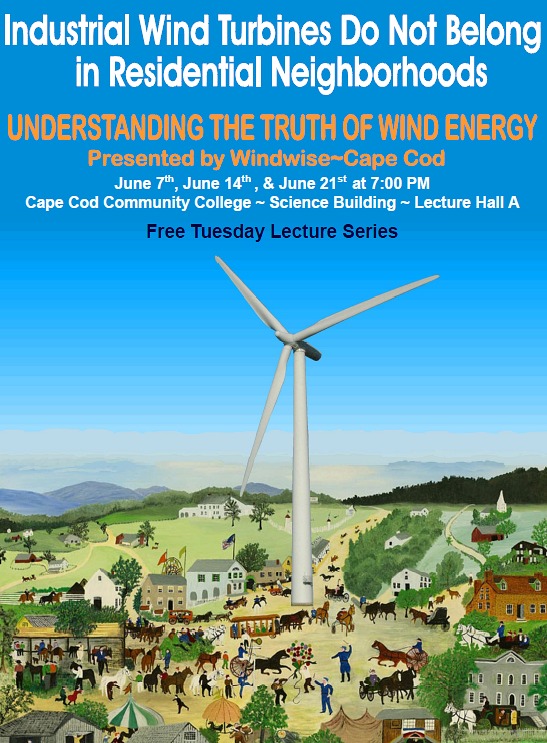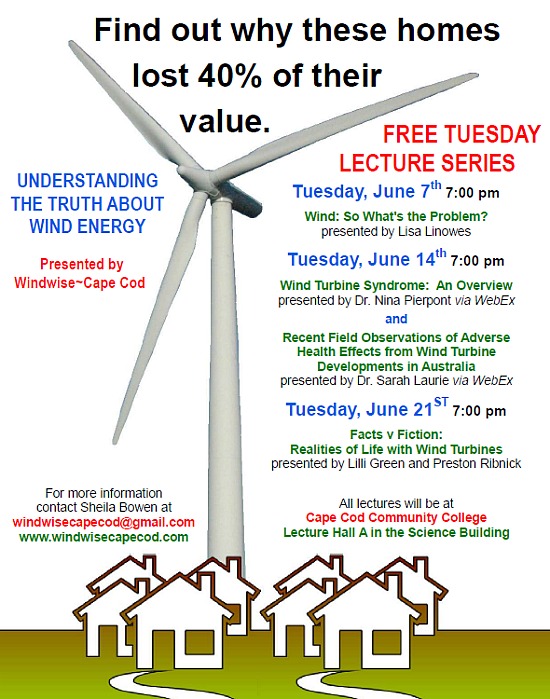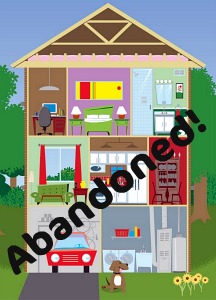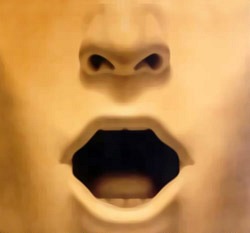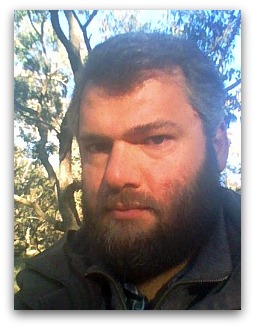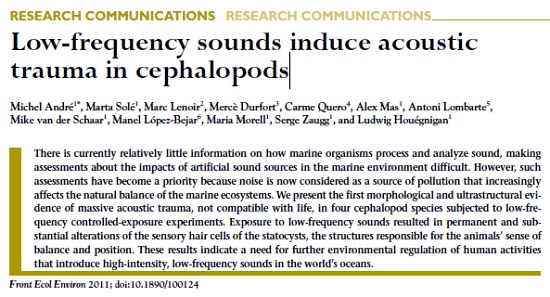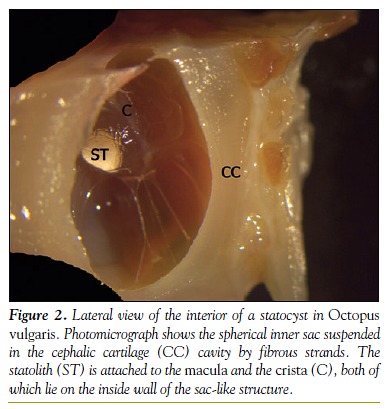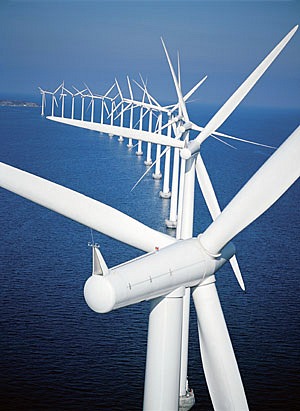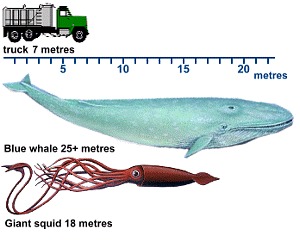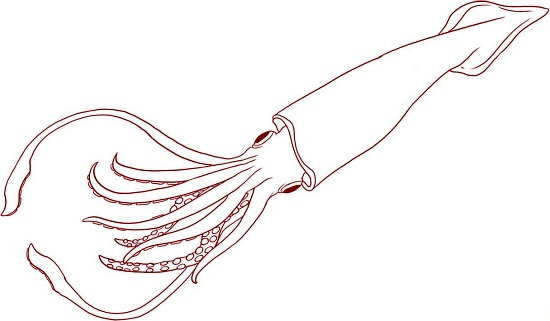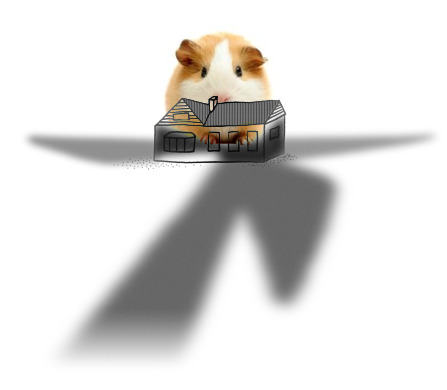“Understanding the Truth of Wind Energy”–Lecture Series, June 2011 (Cape Cod, MA)
—For Immediate Release:
Windwise~Cape Cod Announces June Lecture Series
“Understanding the Truth of Wind Energy”
Cape Cod, MA – May 24, 2011—Windwise Cape Cod is an alliance of neighborhood organizations and dedicated individuals who joined together to promote a more open dialogue on the planned proliferation of wind turbines. Windwise supports a reasoned consideration of the economic feasibility and the adverse effects of wind turbines on Cape Cod.
To this end, Windwise Cape Cod is sponsoring a free lecture series at Cape Cod Community College on the first three Tuesdays of June.
The “Understanding the Truth of Wind Energy” series includes presentations by leading national and international experts who will present the latest research on many aspects of wind energy.
Of special importance will be the presentation on Tuesday, June 14th. Two of the leading international experts on the health risks of wind turbines will present via WebEx. Dr. Nina Pierpont is the author of the most influential book on health problems caused by wind turbines, Wind Turbine Syndrome: A Report on a Natural Experiment (published 2009) and Dr. Sarah Laurie will present from Australia. Dr. Laurie is one of the founders of the Waubra Foundation in Australia, which is devoted to supporting national and international cooperative research initiatives on the health risks of wind turbines.
“Much has happened on Cape Cod since our lectures series in October of last year,” stated Shelia K. Bowen, President of Windwise Cape Cod. “In town after town there is rising controversy over wind turbine projects. Citizens and officials are struggling to better understand the risks and benefits of wind energy. Just a few weeks ago, the Cape Cod Assembly of Delegates adopted a set of Minimum Performance Standards for wind developments. Thus, there is a much greater urgency to ensure all residents and elected and appointed town officials have complete and accurate information on wind energy available to them.”
·
About the “Understanding the Truth of Wind Energy” Speakers
» Tuesday, June 7th, 7 pm Cape Cod Community College, Science Lecture Hall A. “Wind: So What’s the Problem?” presented by Lisa Linowes. Ms. Linowes is the Executive Director for the Industrial Wind Action Group, a national advocacy group focused on the impact/benefit analysis associated with industrial wind energy development. Her presentation will review current energy policies, the scale of proposed wind development nationwide and in Massachusetts, and whether our policy goals adequately satisfy the public’s need for clean, low cost, and reliable energy.
» Tuesday, June 14th, 7 pm Cape Cod Community College, Science Lecture Hall A. “Wind Turbine Syndrome: An Overview” presented by Nina Pierpont, MD (Johns Hopkins), PhD (Population Biology, Princeton), via WebEx. Dr. Pierpont is the author of the peer-reviewed book Wind Turbine Syndrome: A Report on a Natural Experiment, the most influential book published on the health risks of wind turbines (www.windturbinesyndrome.com). She is the leading global authority on this topic and has been interviewed by news organizations and has testified in governmental hearings and court cases around the world.
“Recent Field Observations of Adverse Health Effects from Wind Turbine Developments in Australia,” presented by Sarah Laurie, MD (Flinders University, Australia), via WebEx from Australia. Dr. Laurie is a former rural family physician and one of the founders of the Waubra Foundation in Australia which is devoted to supporting national and international cooperative research initiatives on the health risks of wind turbines.
» Tuesday, June 21st, 7 pm Cape Cod Community College, Science Lecture Hall A. “Facts vs Fiction: Realities of Life with Wind Turbines,” presented by Lilli Green and Preston Ribnick. Lilli and Preston are founding members of Windwise Cape Cod. They are co-owners of a national healthcare consulting firm specializing in educational programs. Lilli and Preston have spent the past 18 months researching the impact of wind turbines on individuals and communities. They recently visited Australia and New Zealand where they videotaped people living in close proximity to wind turbines and international experts on noise and human health. Their presentation will include extensive video interviews. (Read “The Green & Ribnick Report.”)
All lectures are free and open to the public.
Presentations will be followed by a question and answer period.
All lectures will be presented in Science Lecture Hall A, near Parking Lot 7, at Cape Cod Community College, 2240 Iyannough Road (Rt. 132) near the Burger King at Exit 6 off the Mid-Cape Highway (Rt. 6), West Barnstable, MA 02668.
Parking is free.
“The reason we titled this lecture series ‘Understanding the Truth of Wind Energy’ is that there is a vast amount of misinformation that is used to justify the placement of wind turbines in close proximity of homes, schools and businesses,” Ms. Bowen stated. “Windwise Cape Cod is committed to providing researched and accurate information so the citizens and officials on Cape Cod can make informed decisions on this vitally important issue. For this lecture series we will be extending personal invitations to all Cape Cod Boards of Selectmen, members of Planning Boards, Zoning Boards, Boards of Health, town managers, officials of Barnstable County Government, and State Representatives and Senators. We hope each and every one attends the presentations.”
·
About Windwise Cape Cod
Windwise Cape Cod is an alliance of community organizations and citizens formed to have a stronger voice in response to the rapid proliferation of wind turbines proposed and planned for the Cape, Islands and South Coast.
The mission of Windwise Cape Cod is to make complete and accurate information on wind energy available to residents, town governments, and state legislators. In addition, Windwise Cape Cod provides support and guidance to groups and citizens who want to bring information and expertise about wind turbines to their communities.
·
For more information, please contact:
Shelia Bowen, President
Windwise Cape Cod and the Harwich Neighbor Alliance
Phone: 508-432-7956
Email: windwisecapecod@gmail.com


